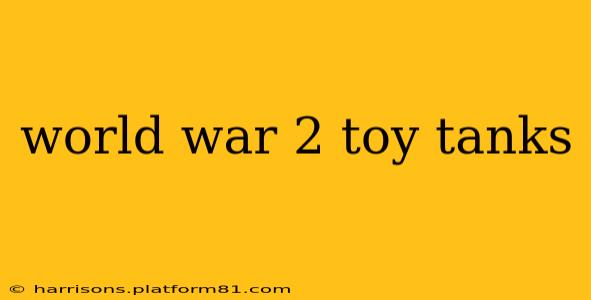World War II toy tanks evoke a powerful sense of nostalgia for many, transporting us back to simpler times filled with imaginative battles and childhood dreams. But these weren't just simple playthings; they reflected the technological marvels and global conflict that captivated the world. This comprehensive guide explores the history, variations, and enduring appeal of World War II toy tanks, delving into the details that make them so sought-after by collectors and enthusiasts today.
What Makes WWII Toy Tanks So Collectible?
The appeal of WWII toy tanks extends beyond mere childhood memories. Their collectibility stems from several key factors:
- Historical Significance: These toys often served as miniature representations of real tanks used in the war, offering a tangible connection to a pivotal moment in history. Collectors appreciate the historical context and the stories these miniature vehicles represent.
- Variety and Rarity: WWII toy tanks were produced by numerous manufacturers across various countries, leading to a diverse range of models, sizes, and materials. Some are incredibly rare, driving up their value significantly.
- Condition and Originality: The condition of a toy tank heavily influences its worth. Original paint, undamaged tracks, and complete accessories significantly increase a tank's collectibility. Boxed examples, especially in pristine condition, are highly prized.
- Nostalgia and Personal Connection: For many, these toys hold sentimental value, reminding them of cherished childhood memories and sparking a connection to a bygone era.
What Types of WWII Toy Tanks Existed?
The world of WWII toy tanks is surprisingly diverse. They varied significantly in:
- Materials: Early examples were often made of cast iron or tinplate, while later toys utilized cheaper materials like plastic.
- Scale: Scale varied greatly, from small, handheld models to larger, more detailed replicas.
- Manufacturers: Iconic manufacturers like Britains, Corgi, and Matchbox produced highly detailed and sought-after models. Less well-known manufacturers also contributed to the market, creating a diverse landscape of collectible items.
- Design: Designs reflected the actual tanks of the time, with variations in turret shape, hull design, and markings.
What Were the Most Popular WWII Toy Tanks?
Pinpointing the most popular is difficult, as popularity is subjective and shifts over time. However, certain models consistently appear on collectors' wish lists:
- Sherman Tank: The ubiquitous American Sherman tank was frequently replicated in toy form, owing to its widespread use and iconic status.
- Tiger Tank: The German Tiger tank, known for its formidable armor, was also a popular subject for toy manufacturers.
- Panzer IV: Another German tank, the Panzer IV, represented a more common, workhorse type of tank which also made its way into toy production.
- T-34: The Soviet T-34, renowned for its sloping armor and reliability, also featured prominently in toy tank collections.
These are just a few examples; many other tank types found their way into toy form, reflecting the vast array of armored vehicles used in the conflict.
How Can I Identify a Valuable WWII Toy Tank?
Determining the value of a WWII toy tank requires careful examination:
- Manufacturer: Identifying the manufacturer is crucial. Renowned manufacturers generally command higher prices.
- Condition: Excellent condition significantly increases value. Look for original paint, minimal wear and tear, and complete accessories.
- Rarity: Rare models or variations are naturally more valuable.
- Box and Accessories: Original packaging and accessories (like figures or weaponry) dramatically boost value.
Online resources, collectors' forums, and auction sites can offer guidance on pricing and identification.
Where Can I Find WWII Toy Tanks?
WWII toy tanks can be found in a variety of places:
- Antique shops and flea markets: These venues often house hidden treasures, including well-preserved toy tanks.
- Online auction sites: Sites like eBay and others specialize in vintage toys and offer a vast selection.
- Collectible toy shops: Specialized shops focusing on vintage toys are excellent resources for locating rare and valuable examples.
- Collectors' shows and events: Toy shows and collecting events offer opportunities to connect with experienced collectors and potentially find unique items.
Are There Any Modern Replicas of WWII Toy Tanks?
While many modern toy manufacturers produce tanks, finding accurate replicas of WWII models that capture the detail and character of their vintage counterparts can be challenging. Many are simplified designs geared towards younger audiences, often lacking the historical accuracy valued by collectors. However, some high-end model manufacturers produce highly accurate and detailed replicas, though these often come with a considerably higher price tag.
This guide provides a starting point for your exploration of the fascinating world of WWII toy tanks. Happy hunting, and may your collection grow!
